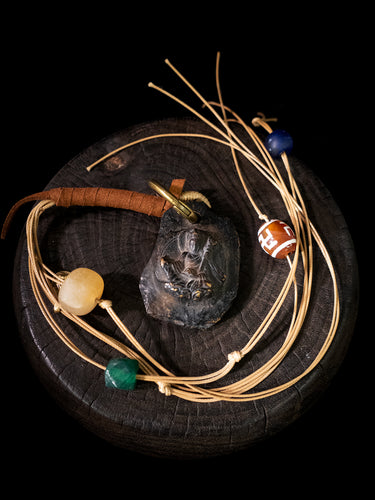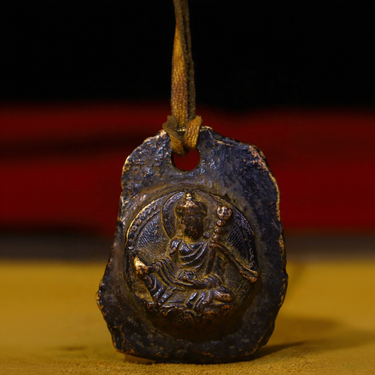
Next, I entered the Potala Palace's painting studio, a tranquil realm where time seemed to stand still. I never imagined that faith could manifest so tangibly, so vibrantly, invoking deep reverence.
As I stepped inside, I saw a group of lamas clad in noble red robes, blending seamlessly with the surrounding artwork, antiques, and the grand palace itself. Ancient bronze Buddha statues, exquisite prayer wheels, and handcrafted thangka frames from centuries past stood silently in a corner, bearing the marks of time, as if witnessing everything that unfolded here. These antiques were not just historical symbols but testimonies of faith passed down through generations. The lamas, whether young or old, stood straight with solemn expressions, their eyes reflecting an indescribable reverence and focus. Their deep red robes were as profound and steadfast as the faith within them. This atmosphere moved me deeply, making me instinctively breathe more lightly, as if afraid to disrupt the solemnity.

Buy the Same Tangka – Click Here✨
Before the master, the young lamas knelt humbly on the ground, reverently offering precious mineral pigments. These pigments, crafted from nature’s finest materials, held colors derived from the stones of snow-capped mountains and river sediments, painstakingly processed to become the vibrant hues in thangka paintings. On one side of the studio, I noticed ancient ceramic jars adorned with weathered patterns, said to have once contained the raw materials for these pigments, passed down through the ages, rich with history. These pigments were not mere materials; they were offerings of faith, each grain imbued with their devotion and profound understanding of life.
At the center of the studio was an ancient painting table, laden with various artistic tools: engraved silver painting knives, bronze ink plates, and stone mortars for grinding pigments, all imbued with a sacred power, witnessing the birth of every thangka. Framed on the walls were ancient thangka paintings, their colors faded yet exuding a weight of time, with every brushstroke reflecting the artisans' dedication to faith and reverence for art.
In a corner, I saw more antique statues and prayer beads hand-carved by the lamas. Made from various precious stones and metals, each bead bore intricate engravings, symbolizing different blessings and prayers. An older lama was focused on carving a Buddha statue, its details exquisitely fine, infused with all his devotion and effort. Each cut expressed his faith and contemplation of life's essence. The prayer beads and statues were not just artworks but external manifestations of the lamas' inner beliefs, each piece radiating deep tranquility and spiritual power.

Buy the Same 108 Mala Beads – Click Here✨
In the studio, the young lamas knelt, carefully passing pigments to the master, sunlight streaming through the windows, illuminating their forms, the pigment jars in their hands, and the unfinished thangka paintings. The interplay of sunlight and color transformed the studio into a living artwork. Their movements were harmonious and reverent, making it clear this was not just a routine but a sacred ritual. As they handed pigments to the master, they attentively observed every step, their eyes filled with admiration and curiosity—a relentless pursuit of knowledge and faith.
In that moment, I deeply felt the power of faith. Faith is not an abstract concept; it exists so tangibly among these people, in their daily actions, and in every detail they dedicate to creating beautiful artwork. The carefully preserved antiques and their present efforts intertwined, narrating a story of continuity and the eternity of faith. That solemnity and seriousness made me realize that faith is the most beautiful part of the human spirit, an intangible force that transcends the physical and worldly, acknowledging and surrendering to the greatness of the universe.
In the sunlight, the vivid reds and multicolored pigments formed a striking contrast. The master worked quietly and intently, while the young lamas learned with respect and stillness, their postures and expressions radiating profound peace. In the corner of the studio lay ancient scrolls and handwritten scriptures, their edges yellowed with age, bearing the weight of countless generations' faith, adding to the sanctity and solemnity of the space. At that moment, I felt enveloped by this tranquility and seriousness, as if all the worldly noise and distractions were isolated outside the studio, leaving only the purest harmony of the soul.
This scene is one I will never forget. It not only awed my senses but also touched my soul. Their devotion to faith, respect for their teachers, and relentless pursuit of art are etched deeply in my heart. This moment of solemnity and purity has become one of my most cherished memories, constantly reminding me of the true meaning of faith and beauty.
We visited the “Yeti White” workshop, a government-run facility in Tibet, where over 300 years of history intertwine. Artisans produce countless gold, silver, and copper crafts each year for the Potala Palace and various Tibetan institutions—from the dazzling golden roofs of the Potala Palace to the stupas of the Dalai Lamas, and the elegantly adorned palaces of Norbulingka, alongside innumerable religious and everyday items. Each piece here carries ancient craftsmanship and faith, infused with historical weight and solemn beauty. These crafts radiate a unique brilliance, merging the sacredness of the Tibetan plateau with humanity’s pursuit of beauty.
In the Potala Palace's painting studio and at Yeti White's artistic facility, I understood that faith is a power—a force that elevates the spirit and purifies the soul. This is the essence I hope to convey through Kailash Energy—to share a sense of tranquility and solemnity derived from the earth and sky, a spiritual connection that transcends the material.
Of course, this fusion of spirit and craftsmanship does not merely dwell in historical continuity; we aim to combine modern design with ancient techniques, allowing more people to experience the depth and beauty of Tibetan culture. Thus, we are bringing the Potala Palace Tibetan series into a new world—one that respects tradition while embracing contemporary aesthetics.

Buy the Same 108 Mala Beads – Click Here✨
Each product possesses a unique soul, from handcrafted silver ornaments to pieces embedded with lapis lazuli and red coral, and scarves woven with auspicious Tibetan patterns. Every design detail reflects reverence for nature and faith. Inspired by the elements of the Potala Palace, we transform them into artworks that can seamlessly integrate into daily life. Each handcrafted ornament pays homage to snowland culture, gazing back in time while celebrating the artisans' generational skills.
Our Potala Palace Tibetan series products are not merely accessories; they are vessels of stories, conveying the culture and spirit of the Tibetan plateau. For instance, our gold necklaces draw inspiration from the golden roof of the Potala Palace, symbolizing light, dignity, and wisdom, allowing wearers to feel an inner strength and courage. The lapis lazuli-embedded rings represent the pure blue sky of Tibet and an otherworldly sense of tranquility; seeing them evokes the sound of wind sweeping across the plateau, letting one feel the vastness and mystery of the land.
The launch of this series aims for people to find their own tranquility and strength amid bustling urban life, much like the Potala Palace stands silently atop the plateau, removed from chaos, facing the heavens, exuding an indescribable power and solemnity. We hope that those who wear these pieces carry not just an accessory but a piece of history, a share of faith, and a pursuit of beauty into their lives.
We continue to explore Tibet's rich cultural heritage, blending more ancient techniques with modern aesthetics to create more works that embody snowland culture. Each piece is a journey, a spiritual passage from the snow mountains to the city, from the past to the future. And we, as guides, lead everyone to explore the untold stories of Tibetan culture and experience the tranquility and solemnity hidden between heaven and earth.
























